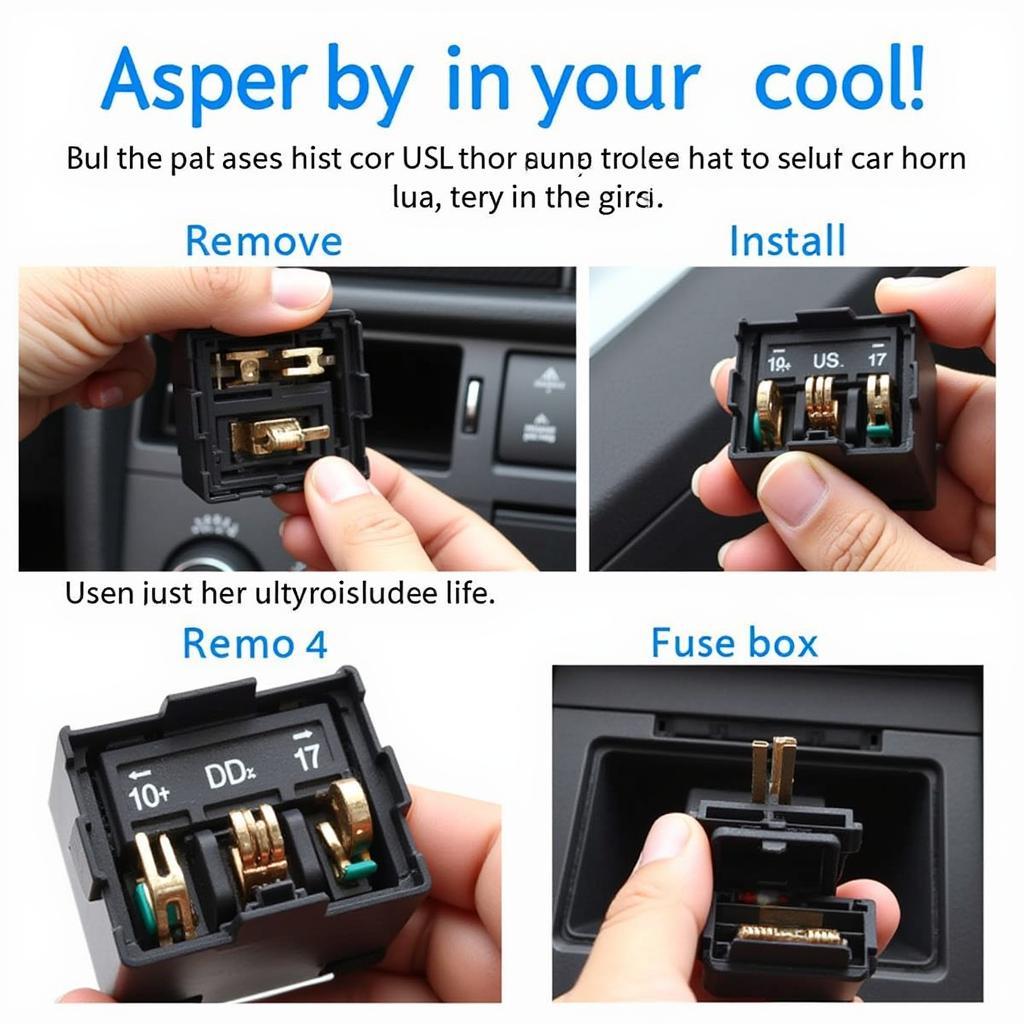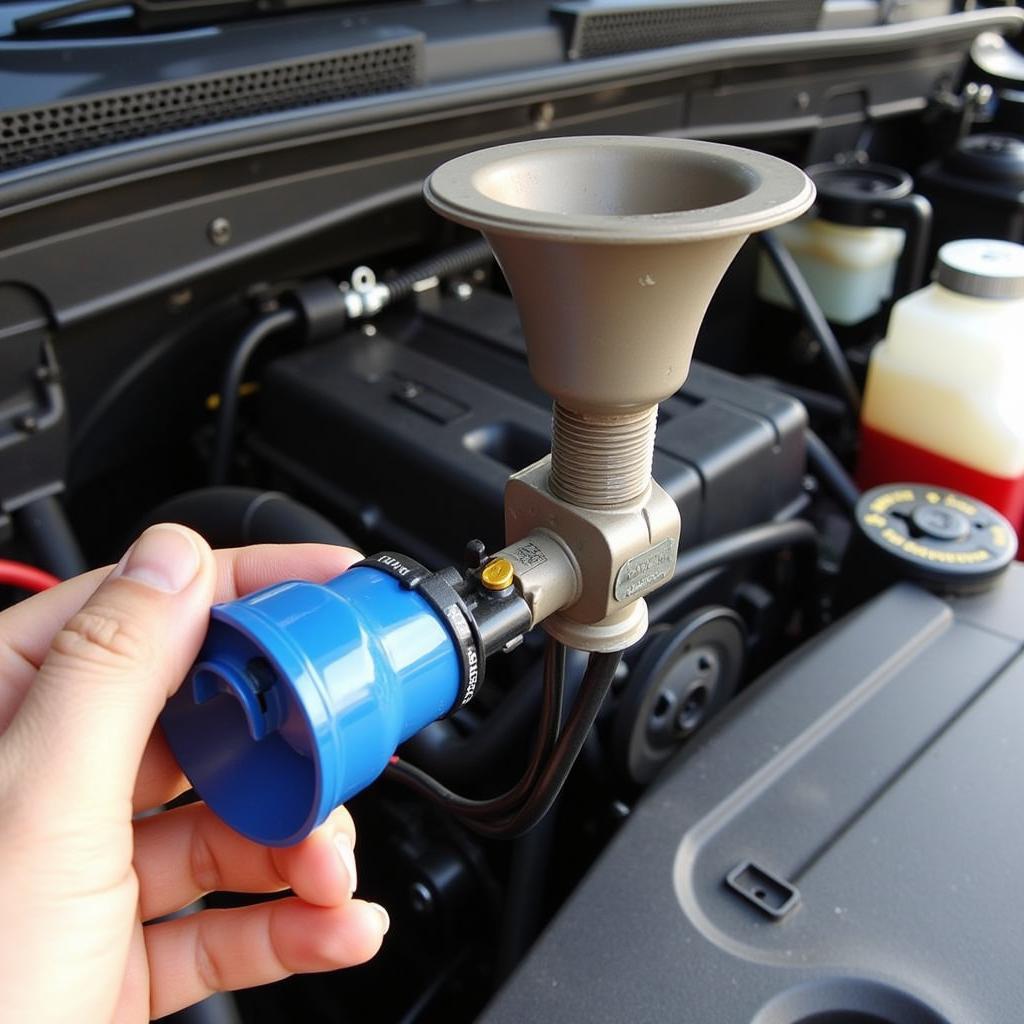A faulty car horn can be a major safety hazard, preventing you from alerting other drivers or pedestrians to your presence. Understanding the potential causes and solutions can save you time and money. This comprehensive guide will walk you through diagnosing and fixing a Faulty Car Horn Problem, empowering you to get back on the road safely.
Similar to car timing belt problem symptoms, a faulty car horn can sometimes be a symptom of a larger electrical issue. Let’s explore the common reasons behind this frustrating issue.
Why is My Car Horn Not Working?
There are several reasons why your car horn might not be functioning correctly. These range from simple fixes like a blown fuse to more complex issues like a damaged clock spring or a faulty horn relay.
- Blown Fuse: One of the most common culprits is a blown fuse. Fuses protect the electrical circuits in your car, and a surge in power can cause the horn fuse to blow, rendering the horn inoperable.
- Faulty Horn Relay: The horn relay acts as a switch, allowing a larger current to flow to the horn when you press the horn button. If the relay is faulty, the horn won’t receive the necessary power to sound.
- Damaged Clock Spring: Located within the steering wheel, the clock spring allows the electrical connections for the horn, airbag, and other steering wheel controls to function even when the wheel is turned. If the clock spring is damaged, it can disrupt the horn circuit.
- Wiring Issues: Corroded, damaged, or loose wiring can also prevent the horn from working correctly. This can occur anywhere along the wiring harness, from the horn button to the horn itself.
- Faulty Horn: The horn itself can fail due to internal damage or exposure to the elements. Over time, the internal components can wear out or become corroded, leading to a malfunctioning horn.
How to Diagnose a Faulty Car Horn
Diagnosing a faulty car horn problem involves a systematic approach to identify the root cause. Here’s a step-by-step guide to help you pinpoint the issue:
- Check the Fuse: Locate the horn fuse in your car’s fuse box (usually under the dashboard or in the engine compartment). Consult your owner’s manual for the exact location. Inspect the fuse for any signs of damage, such as a broken filament.
- Test the Horn Relay: If the fuse is intact, the next step is to test the horn relay. You can swap the horn relay with another relay of the same type in your fuse box. If the horn works after swapping relays, the original horn relay is faulty.
- Inspect the Wiring: Visually inspect the wiring connected to the horn and the horn button for any signs of damage, corrosion, or loose connections.
- Test the Horn Directly: If the wiring appears intact, you can test the horn directly by applying 12 volts to its terminals. If the horn sounds, the problem lies elsewhere in the circuit, such as the clock spring or wiring. Just like with car problem motorcycle noise, tracing the source of the issue is key.
- Check the Clock Spring: Testing the clock spring requires specialized tools and knowledge. If you suspect a faulty clock spring, it’s best to consult a qualified mechanic.
How to Fix a Faulty Car Horn Problem
Once you’ve identified the cause of the problem, you can take the appropriate steps to fix it.
- Replace the Fuse: If the fuse is blown, simply replace it with a new fuse of the same amperage rating.
- Replace the Relay: If the relay is faulty, replace it with a new one.
- Repair or Replace Wiring: If the wiring is damaged, repair or replace the affected sections.
- Replace the Horn: If the horn itself is faulty, replace it with a new one.
- Replace the Clock Spring: If the clock spring is damaged, it needs to be replaced. This is best done by a professional mechanic.
 Replacing Car Horn Relay
Replacing Car Horn Relay
Expert Insights
John Smith, a seasoned automotive electrician with over 20 years of experience, emphasizes the importance of checking the fuse first when troubleshooting a faulty car horn: “Nine times out of ten, it’s a simple blown fuse. It’s the easiest and cheapest fix.”
 Testing Car Horn with Multimeter
Testing Car Horn with Multimeter
Maria Garcia, a certified mechanic specializing in automotive electrical systems, highlights the significance of proper wiring: “Loose or corroded connections can cause intermittent horn problems, which can be frustrating to diagnose. Thoroughly inspecting the wiring is crucial.”
This is similar to diagnosing common problems audi car complaints, where systematic troubleshooting is key.
Conclusion
A faulty car horn can be a nuisance and a safety concern. By understanding the potential causes and following the diagnostic steps outlined in this guide, you can effectively troubleshoot and fix the problem. Don’t hesitate to contact us at AutoTipPro for further assistance. Our phone number is +1 (641) 206-8880 and our office is located at 500 N St Mary’s St, San Antonio, TX 78205, United States. We are always happy to help.
 New Car Horn Installation
New Car Horn Installation
Just like understanding the thermostat in car problems, addressing a faulty car horn promptly ensures your safety on the road. And if you are in the market for a used car, be aware of potential issues, like those detailed in 99 lexus gs 400 problem car for sale.
FAQ
- What is the most common cause of a faulty car horn? A blown fuse is often the culprit.
- How do I test my car horn relay? Swap it with a similar relay in your fuse box.
- Can I fix a damaged clock spring myself? It’s best to consult a mechanic for this repair.
- How much does a new car horn cost? Prices vary depending on the make and model of your car.
- Where is the horn fuse located? Check your owner’s manual for the precise location.
- What tools do I need to diagnose a faulty car horn? Basic tools like a screwdriver, test light, and multimeter are helpful.
- Is it safe to drive with a faulty car horn? It’s a safety hazard, so it’s best to fix it as soon as possible.




Leave a Reply